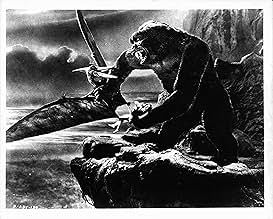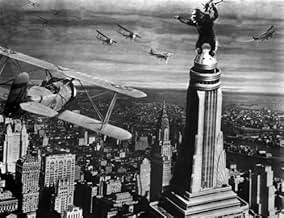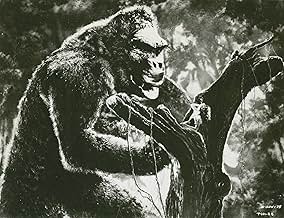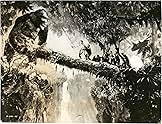A film crew goes to a tropical island for a location shoot, where they capture a colossal ape who takes a shine to their blonde starlet, and bring him back to New York City.A film crew goes to a tropical island for a location shoot, where they capture a colossal ape who takes a shine to their blonde starlet, and bring him back to New York City.A film crew goes to a tropical island for a location shoot, where they capture a colossal ape who takes a shine to their blonde starlet, and bring him back to New York City.
- Awards
- 3 wins & 8 nominations
Steve Clemente
- Witch King
- (as Steve Clemento)
Walter Ackerman
- Reporter
- (uncredited)
James Adamson
- Native Child
- (uncredited)
Van Alder
- Member of Ship's Crew
- (uncredited)
Etta Mae Allen
- Native
- (uncredited)
Frank Angel
- Reporter
- (uncredited)
Roscoe Ates
- Press Photographer
- (uncredited)
Ralph Bard
- Member of Ship's Crew
- (uncredited)
Reginald Barlow
- Ship's Engineer
- (uncredited)
Leo Beard
- Member of Ship's Crew
- (uncredited)
Storyline
Did you know
- TriviaThe film grossed $90,000 its opening weekend, the biggest opening ever at the time.
- Goofs(at around 1h 14 mins) A Skull Island resident jumps from a hut and falls beside a domed chicken cage, which then hinges backwards and catches the actor's wig, taking it off his head, and remaining on top of the cage.
- Quotes
[last lines]
Police Lieutenant: Well, Denham, the airplanes got him.
Carl Denham: Oh no, it wasn't the airplanes. It was beauty killed the beast.
- Crazy creditsOpening Card: And the prophet said: "And lo, the beast looked upon the face of beauty. And it stayed its hand from killing. And from that day, it was as one dead." Old Arabian Proverb
- Alternate versionsOn November 22, 2005, Turner Classic Movies premiered a version with a four minute overture added. This increased the run time to slightly over 104 minutes. This is also the U.S. two-disc DVD collector's edition version. Note, however, that the overture was not part of the film's original exhibition. According to John Morgan's notes on the score's re-construction, the overture was not written by Max Steiner. Morgan writes, "Another rumour has recently surfaced that Steiner composed an Overture for the film's world premiere opening in 1933 - there was even a recent recording claiming to be this long-lost Overture. Hearing the recorded "proof" of this Overture confirmed our suspicions: it was merely those same few acetates that have been floating around for years, professionally edited into a short Suite and called an Overture. In conversations I had with people who attended and remembered this opening, there was no music from the film used in any of these shows." Source: John Morgan, "Reconstruction Notes by John Morgan," Steiner: King Kong. Marco Polo (8.223763), 1997, pg. 21 (near bottom).
- ConnectionsEdited into The Ghost Ship (1943)
Featured review
First, the 1933 version of KING KONG, is for me, the greatest fantasy film ever made. Sure, there are fantasy films with far better special effects (THE MATRIX, JURASSIC PARK) better acting (the acting here is of the period!) but KING KONG is a film of tremendous excitement. The suspense, pacing, sensuality, violence all adds up to a blood pumping experience. We all read about the film's history, being made, released, censored, restored, and how it's been picked to itsy-bits by every arm-chair film "expert".
What very few film-makers have focused on is the film-making itself in KING KONG. It has superb build-up. We are wondering what is on the island as we approach it. Then we wonder what is behind the wall on the island. Then we wonder what gigantic beast is sharing that frightening jungle with the rescuers, trying to save Fay Wray. The film is faultlessly edited. Many scenes begin or end with people running for their lives. Unneeded scenes just don't exsist (we go from Kong knocked out on Skull Island to his Broadway debut. We don't need to see what happens inbetween!) then there's Max Steiner's perfect music score. Before KONG, most music scores were borrowed snippets of classical or popular themes, but Steiner's score follows the action to an inch! Also, he does a great number of abstract musical strokes (I.e the clash of drums when Kong beats the giant snake to it's death. The lovely string piece that jumps to pulsating chase music in a milli-second.) When I hear of a friend say they never saw this film, it's like hearing a child say they never had ice cream. Long Live Kong!
What very few film-makers have focused on is the film-making itself in KING KONG. It has superb build-up. We are wondering what is on the island as we approach it. Then we wonder what is behind the wall on the island. Then we wonder what gigantic beast is sharing that frightening jungle with the rescuers, trying to save Fay Wray. The film is faultlessly edited. Many scenes begin or end with people running for their lives. Unneeded scenes just don't exsist (we go from Kong knocked out on Skull Island to his Broadway debut. We don't need to see what happens inbetween!) then there's Max Steiner's perfect music score. Before KONG, most music scores were borrowed snippets of classical or popular themes, but Steiner's score follows the action to an inch! Also, he does a great number of abstract musical strokes (I.e the clash of drums when Kong beats the giant snake to it's death. The lovely string piece that jumps to pulsating chase music in a milli-second.) When I hear of a friend say they never saw this film, it's like hearing a child say they never had ice cream. Long Live Kong!
Details
Box office
- Budget
- $670,000 (estimated)
- Gross worldwide
- $651
- Runtime1 hour 40 minutes
- Color
Contribute to this page
Suggest an edit or add missing content































